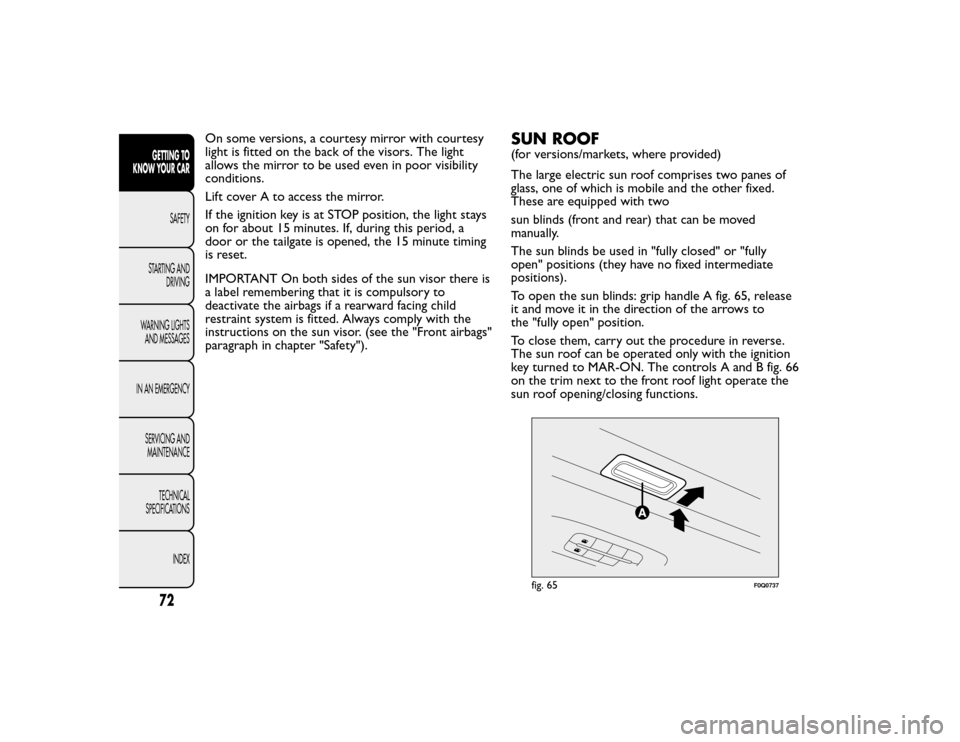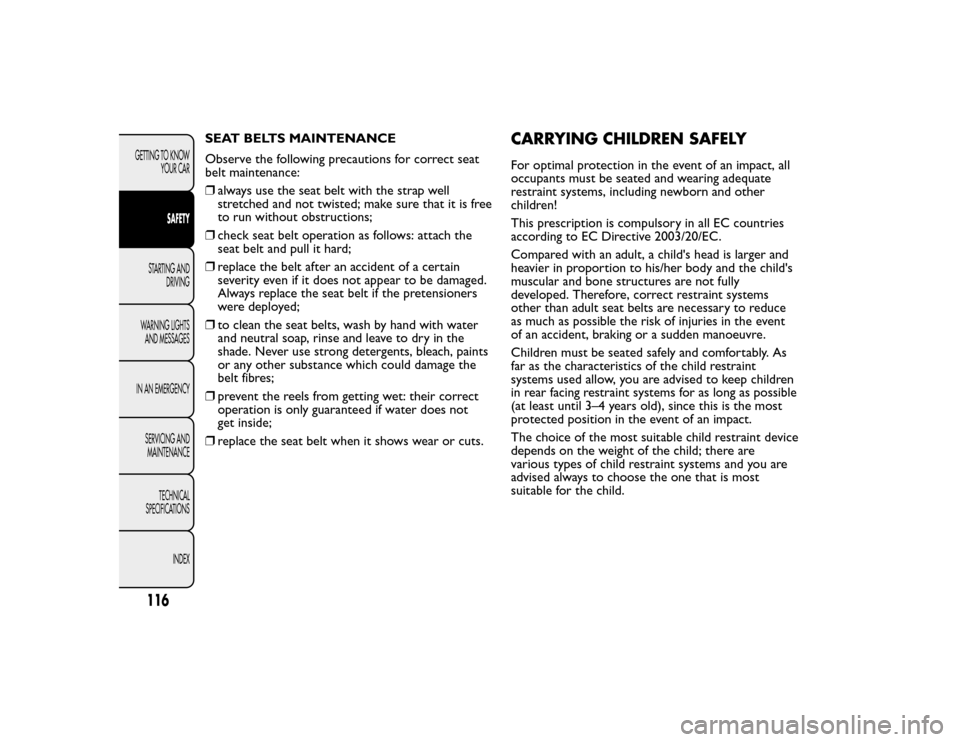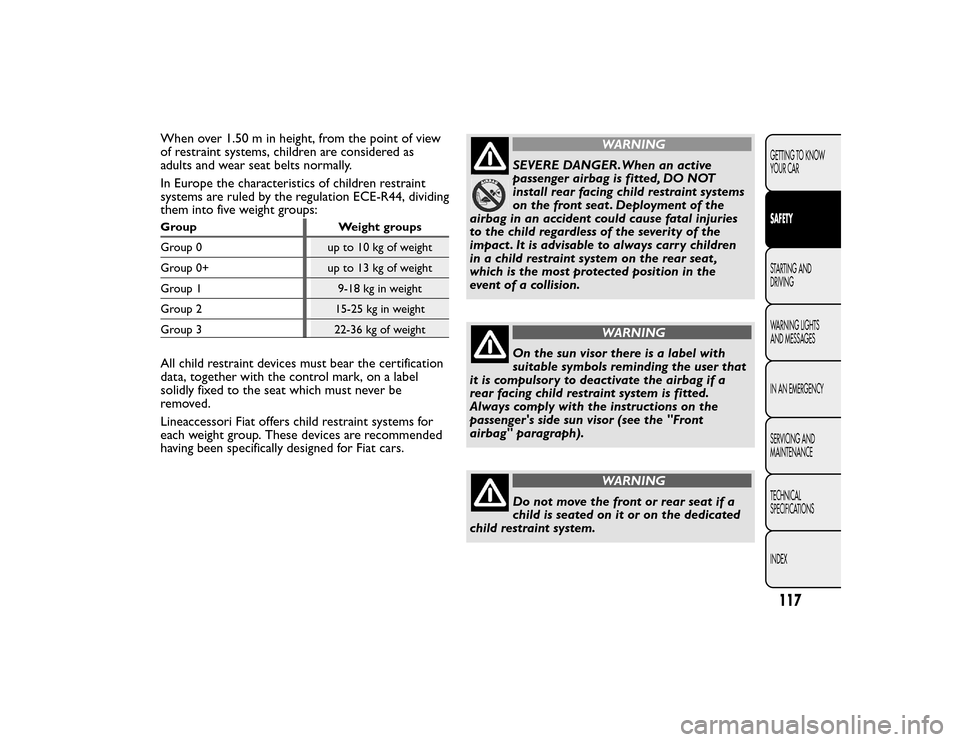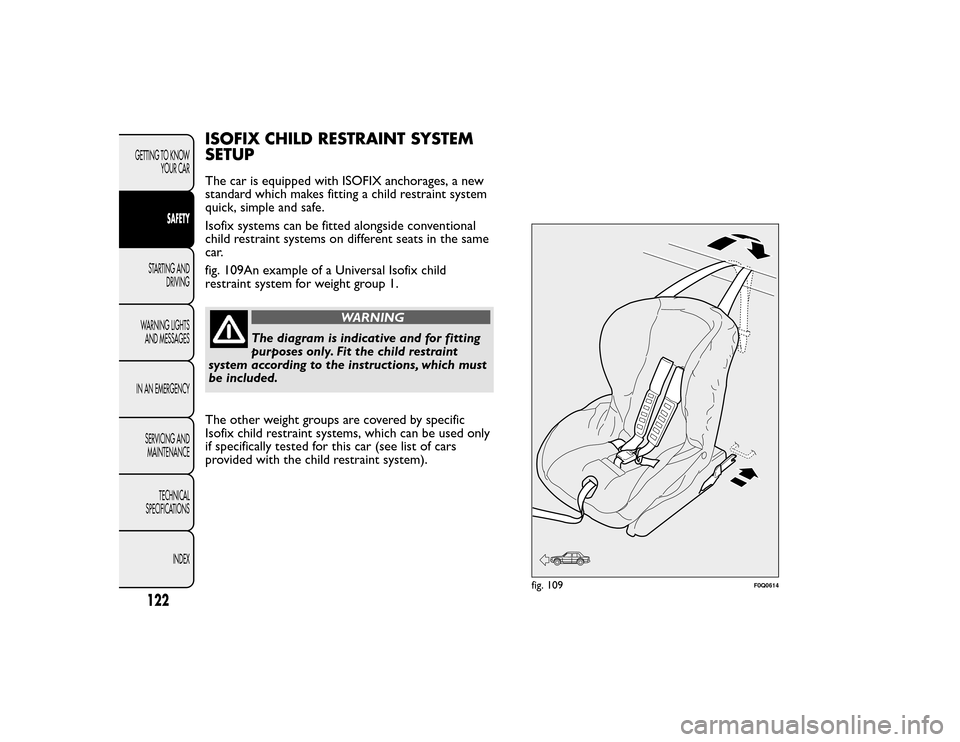child restraint FIAT BRAVO 2015 2.G Owners Manual
[x] Cancel search | Manufacturer: FIAT, Model Year: 2015, Model line: BRAVO, Model: FIAT BRAVO 2015 2.GPages: 275, PDF Size: 7.55 MB
Page 76 of 275

On some versions, a courtesy mirror with courtesy
light is fitted on the back of the visors. The light
allows the mirror to be used even in poor visibility
conditions.
Lift cover A to access the mirror.
If the ignition key is at STOP position, the light stays
on for about 15 minutes. If, during this period, a
door or the tailgate is opened, the 15 minute timing
is reset.
IMPORTANT On both sides of the sun visor there is
a label remembering that it is compulsory to
deactivate the airbags if a rearward facing child
restraint system is fitted. Always comply with the
instructions on the sun visor. (see the "Front airbags"
paragraph in chapter "Safety").
SUN ROOF(for versions/markets, where provided)
The large electric sun roof comprises two panes of
glass, one of which is mobile and the other fixed.
These are equipped with two
sun blinds (front and rear) that can be moved
manually.
The sun blinds be used in "fully closed" or "fully
open" positions (they have no fixed intermediate
positions).
To open the sun blinds: grip handle A fig. 65, release
it and move it in the direction of the arrows to
the "fully open" position.
To close them, carry out the procedure in reverse.
The sun roof can be operated only with the ignition
key turned to MAR-ON. The controls A and B fig. 66
on the trim next to the front roof light operate the
sun roof opening/closing functions.
fig. 65
F0Q0737
72GETTING TO
KNOW YOUR CAR
SAFETY
STARTING AND DRIVING
WARNING LIGHTS AND MESSAGES
IN AN EMERGENCY SERVICING ANDMAINTENANCE
TECHNICAL
SPECIFICATIONS
INDEX
Page 120 of 275

SEAT BELTS MAINTENANCE
Observe the following precautions for correct seat
belt maintenance:
❒always use the seat belt with the strap well
stretched and not twisted; make sure that it is free
to run without obstructions;
❒ check seat belt operation as follows: attach the
seat belt and pull it hard;
❒ replace the belt after an accident of a certain
severity even if it does not appear to be damaged.
Always replace the seat belt if the pretensioners
were deployed;
❒ to clean the seat belts, wash by hand with water
and neutral soap, rinse and leave to dry in the
shade. Never use strong detergents, bleach, paints
or any other substance which could damage the
belt fibres;
❒ prevent the reels from getting wet: their correct
operation is only guaranteed if water does not
get inside;
❒ replace the seat belt when it shows wear or cuts.
CARRYING CHILDREN SAFELYFor optimal protection in the event of an impact, all
occupants must be seated and wearing adequate
restraint systems, including newborn and other
children!
This prescription is compulsory in all EC countries
according to EC Directive 2003/20/EC.
Compared with an adult, a child's head is larger and
heavier in proportion to his/her body and the child's
muscular and bone structures are not fully
developed. Therefore, correct restraint systems
other than adult seat belts are necessary to reduce
as much as possible the risk of injuries in the event
of an accident, braking or a sudden manoeuvre.
Children must be seated safely and comfortably. As
far as the characteristics of the child restraint
systems used allow, you are advised to keep children
in rear facing restraint systems for as long as possible
(at least until 3–4 years old), since this is the most
protected position in the event of an impact.
The choice of the most suitable child restraint device
depends on the weight of the child; there are
various types of child restraint systems and you are
advised always to choose the one that is most
suitable for the child.
116GETTING TO KNOW
YOUR CAR
SAFETY
STARTING AND DRIVING
WARNING LIGHTS AND MESSAGES
IN AN EMERGENCY SERVICING ANDMAINTENANCE
TECHNICAL
SPECIFICATIONS
INDEX
Page 121 of 275

When over 1.50 m in height, from the point of view
of restraint systems, children are considered as
adults and wear seat belts normally.
In Europe the characteristics of children restraint
systems are ruled by the regulation ECE-R44, dividing
them into five weight groups:GroupWeight groups
Group 0 up to 10 kg of weight
Group 0+ up to 13 kg of weight
Group 1 9-18 kg in weight
Group 2 15-25 kg in weight
Group 3 22-36 kg of weightAll child restraint devices must bear the certification
data, together with the control mark, on a label
solidly fixed to the seat which must never be
removed.
Lineaccessori Fiat offers child restraint systems for
each weight group. These devices are recommended
having been specifically designed for Fiat cars.
WARNING
SEVERE DANGER.When an active
passenger airbag is fitted, DO NOT
install rear facing child restraint systems
on the front seat . Deployment of the
airbag in an accident could cause fatal injuries
to the child regardless of the severity of the
impact . It is advisable to always carr y children
in a child restraint system on the rear seat ,
which is the most protected position in the
event of a collision.WARNING
On the sun visor there is a label with
suitable symbols reminding the user that
it is compulsory to deactivate the airbag if a
rear facing child restraint system is fitted.
Always comply with the instructions on the
passenger's side sun visor (see the "Front
airbag" paragraph).WARNING
Do not move the front or rear seat if a
child is seated on it or on the dedicated
child restraint system.
117GETTING TO KNOW
YOUR CAR
SAFETY
STARTING AND
DRIVING
WARNING LIGHTS
AND MESSAGES
IN AN EMERGENCY
SERVICING AND
MAINTENANCE
TECHNICAL
SPECIFICATIONS
INDEX
Page 122 of 275

FITTING "UNIVERSAL"
CHILD RESTRAINT SYSTEM
(with seat belts)GROUP 0 and 0+
WARNING
The diagram is indicative and for fitting
purposes only. Fit the child restraint
system according to the instructions, which must
be included.
Children up to 13 kg must be carried with rearward
facing restraint system of a type as shown in fig. 105
which, supporting the head, does not induce stress
on the neck in the event of sudden decelerations.
The rearward facing infant seat is restrained by the
car seat belts, as shown in fig. 105 and it must
restrain the child in turn with its own belts.
GROUP 1WARNING
The diagram is indicative and for fitting
purposes only. Fit the child restraint
system according to the instructions, which must
be included. Children of weight from 9 to 18 kg may be carried in
forward facing child restraint systems fig. 106.
fig. 105
F0Q0429
fig. 106
F0Q0772
118GETTING TO KNOW
YOUR CAR
SAFETY
STARTING AND DRIVING
WARNING LIGHTS AND MESSAGES
IN AN EMERGENCY SERVICING ANDMAINTENANCE
TECHNICAL
SPECIFICATIONS
INDEX
Page 123 of 275

WARNING
Child restraint systems with Isofix
attachments are available for a safe
anchoring to the seat without using the car seat
belts.
GROUP 2WARNING
The diagram is indicative and for fitting
purposes only. Fit the child restraint
system according to the instructions, which must
be included. Children from 15 to 25 kg may use the car seat belts
directly fig. 107.
In this case, the child restraint system is used to
position the child correctly with respect to the seat
belts so that the diagonal belt section crosses the
child’s chest and not the neck, and the lower part is
snug on the pelvis not the abdomen.
fig. 107
F0Q0431
119GETTING TO KNOW
YOUR CAR
SAFETY
STARTING AND
DRIVING
WARNING LIGHTS
AND MESSAGES
IN AN EMERGENCY
SERVICING AND
MAINTENANCE
TECHNICAL
SPECIFICATIONS
INDEX
Page 124 of 275

GROUP 3
WARNING
The diagram is indicative and for fitting
purposes only. Fit the child restraint
system according to the instructions, which must
be included.
For children between 22 kg and 36 kg, there are
dedicated restraint systems that allow the seat belt
to be worn correctly. The fig. 108 shows the correct child positioning on
the rear seat.
Children over 1.50 m in height can wear seat belts
like adults.
fig. 108
F0Q0432
120GETTING TO KNOW
YOUR CAR
SAFETY
STARTING AND DRIVING
WARNING LIGHTS AND MESSAGES
IN AN EMERGENCY SERVICING ANDMAINTENANCE
TECHNICAL
SPECIFICATIONS
INDEX
Page 125 of 275

SUITABILITY OF PASSENGER SEATS FOR UNIVERSAL RESTRAINT SYSTEM USE
According to the European Directive 2000/3/EC the suitability of each passenger seat position for the fixing
of universal child restraint systems is shown in the following table:GroupWeight range Front passenger Rear side passengers Rear central
passenger
Group 0, 0+ up to 13 kg
UUU
Group 1 9–18 kg
UUU
Group 215–25 kg
UUU
Group 322–36 kg
UUU
U= suitable for child restraint systems in the "Universal" category, according to European Regulation EEC-R44 for the specified "Groups".
121GETTING TO KNOW
YOUR CAR
SAFETY
STARTING AND
DRIVING
WARNING LIGHTS
AND MESSAGES
IN AN EMERGENCY
SERVICING AND
MAINTENANCE
TECHNICAL
SPECIFICATIONS
INDEX
Page 126 of 275

ISOFIX CHILD RESTRAINT SYSTEM
SETUPThe car is equipped with ISOFIX anchorages, a new
standard which makes fitting a child restraint system
quick, simple and safe.
Isofix systems can be fitted alongside conventional
child restraint systems on different seats in the same
car.
fig. 109An example of a Universal Isofix child
restraint system for weight group 1.
WARNING
The diagram is indicative and for fitting
purposes only. Fit the child restraint
system according to the instructions, which must
be included.
The other weight groups are covered by specific
Isofix child restraint systems, which can be used only
if specifically tested for this car (see list of cars
provided with the child restraint system).
fig. 109
F0Q0614
122GETTING TO KNOW YOUR CAR
SAFETY
STARTING AND DRIVING
WARNING LIGHTS AND MESSAGES
IN AN EMERGENCY SERVICING ANDMAINTENANCE
TECHNICAL
SPECIFICATIONS
INDEX
Page 127 of 275

INSTALLING A UNIVERSAL ISOFIX CHILD
RESTRAINT SYSTEM
Attach the restraint system to the two metal
anchorages A fig. 110 located where the rear seat
cushion meets the backrest, then fix the upper strap
(available together with the restraint system) to
the dedicated anchorage B fig. 111 located at the
bottom behind the backrest.
Remember that when using a Universal Isofix child
restraint system, you can use approved child restraint
systems with the marking ECE R44/03 (R44/03 or
superior) “Universal Isofix”.
WARNING
If a Universal Isofix child seat is not
fixed to all three anchorages, the child
seat will not be able to protect the child
correctly. In a crash, the child could be seriously
or fatally injured. The Universal Isofix “Duo Plus” child seat and the
special "G 0/1" seat are available from Lineaccessori
Fiat.
For any further details on installation/use, refer to
the instruction manual for the child seat.
WARNING
Fit the child seat when the car is
stationary.The child seat is correctly
anchored to the brackets when you hear the
click. Follow the instructions for assembly,
disassembly and positioning that the
manufacturer must supply with the child seat .
fig. 110
F0Q0698
fig. 111
F0Q0699
123GETTING TO KNOW
YOUR CAR
SAFETY
STARTING AND
DRIVING
WARNING LIGHTS
AND MESSAGES
IN AN EMERGENCY
SERVICING AND
MAINTENANCE
TECHNICAL
SPECIFICATIONS
INDEX
Page 128 of 275

SUITABILITY OF PASSENGER SEATS FOR ISOFIX CHILD RESTRAINT SYSTEM USE
The table below shows the various installation possibilities for Isofix child restraint systems on seats fitted
with Isofix attachments in accordance with European standard ECE 16.Weight groupChild restraint system
position Isofix size class Rear side passengers
Group 0 up to 10 kg Rear facingE
IL
Group 0+ up to 13 kg Rear facing
E
IL
Rear facingD
IL
Rear facing C
IL (*)
Group 1 from 9 up to 18 kg Facing backwards
D
IL
Facing backwards C
IL (*)
Forward facingB
IUF
Forward facingBI
IUF
Forward facing A
IUF
IL : suitable for ISOFIX child restraint systems of the categories for "specific vehicles", "restricted", or "semiuniversal", approved for this type of vehicle.
(*)The Isofix child seat can be installed by moving the front seat all the way up.
IL Suitable for special child restraint systems. Isofix type suitable and tested for this type of car. The seat can be installed by moving the front seat forward.
IUF: suitable for forward facing Isofix child restraint systems in the Universal category and type-approved for the use in the weight group.
124GETTING TO KNOW YOUR CAR
SAFETY
STARTING AND DRIVING
WARNING LIGHTS AND MESSAGES
IN AN EMERGENCY SERVICING ANDMAINTENANCE
TECHNICAL
SPECIFICATIONS
INDEX